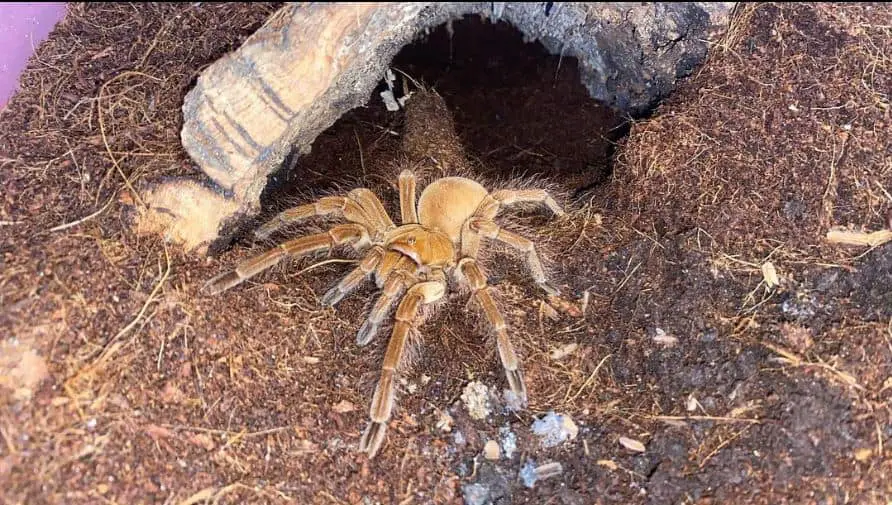The Goliath Birdeater Tarantula (Theraphosa blondi) is the largest tarantula species in the world. These giant spiders have long fascinated people around the world, so it’s not very surprising that they’ve become very popular among hobbyists.
However, due to their large size, urticating hairs, fast speed, and defensive nature they’re not all too suitable for first-timers.
If the Goliath Birdeater Tarantula’s large size has caught your attention, and you’re considering adding one to your collection then you’ve come to the right place because we’ll tell you everything you need to know about them.
Goliath Birdeater Tarantula Care Sheet
| Species Name | Theraphosa Blondi |
| Family Name | Theraphosidae |
| Common Names | Goliath Birdeater Tarantula |
| Category | New World |
| Type | Terrestrial |
| Native Location | North Brazil, French Guiana, Guiana, Suriname, South Venezuela |
| Body Length | 4 inches (10 cm) |
| Leg Span | 11 inches (28 cm) |
| Growth Speed | Fast |
| Urticating Hairs | Yes |
| Social | Solitary |
| Diet | Insects: primarily crickets and roaches. Small rodents/lizards |
| Temperature | 76 to 84 degrees °F |
| Humidity | 80 to 90% |
| Lifespan | Female: 25 years / Male: 5 years |
| Experience required | Advanced |
| Minimum tank size | 24L”x16W”x16H” |
Goliath Birdeater Tarantula Overview
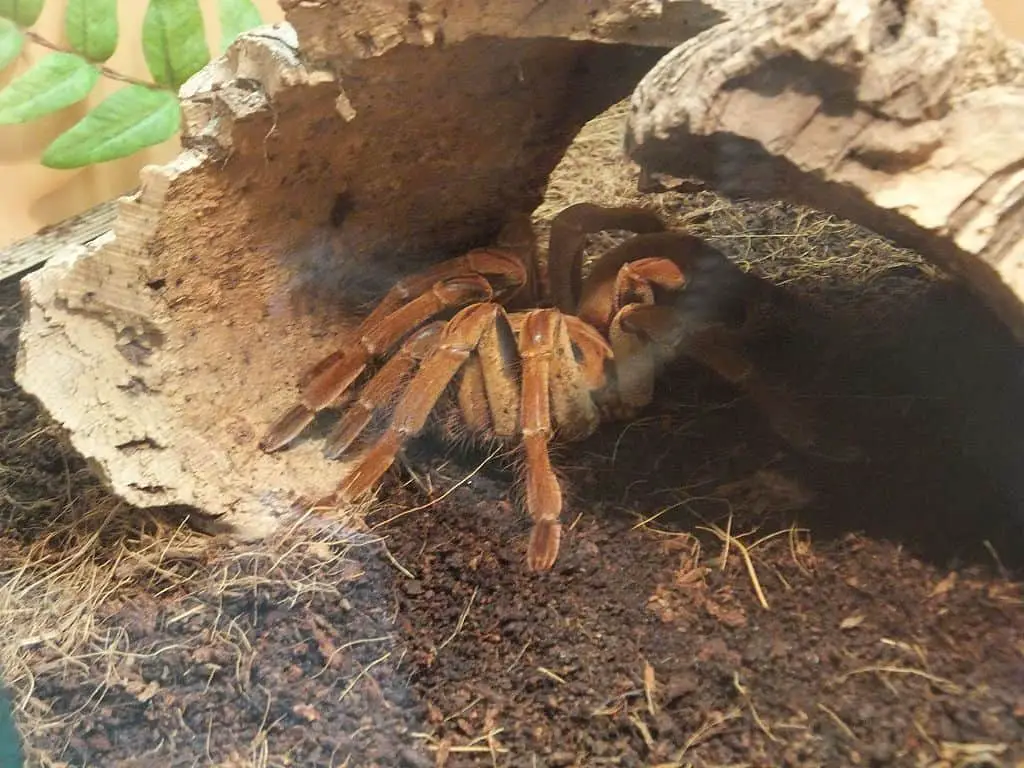
The Theraphosa Blondi, known in the hobby as the Goliath Birdeater Tarantula, is a massive spider that’s native to North Brazil, French Guiana, Guiana, Suriname, and the South of Venezuela.
They’re a New World terrestrial tarantula that spends the majority of its life in a burrow that it creates under rocks and roots. They line these burrows with silk and also spin webs in front of it to help them hunt.
They eat a variety of different insects, but due to their large size, they’re also capable of eating lizards, and even small mammals and birds when they get the chance to grab them with their massive fangs.
As is the case with many New World species, they have urticating hairs which they use to defend themselves from predators.
A unique feature of this species is that they’re capable of making sounds. While most tarantulas are quiet animals, the T. Blondi is capable of rubbing its hair together to make a hissing noise that can be heard as far as 15 feet away. They typically make this sound when they feel threatened to scare off predators.
Appearance & Variants
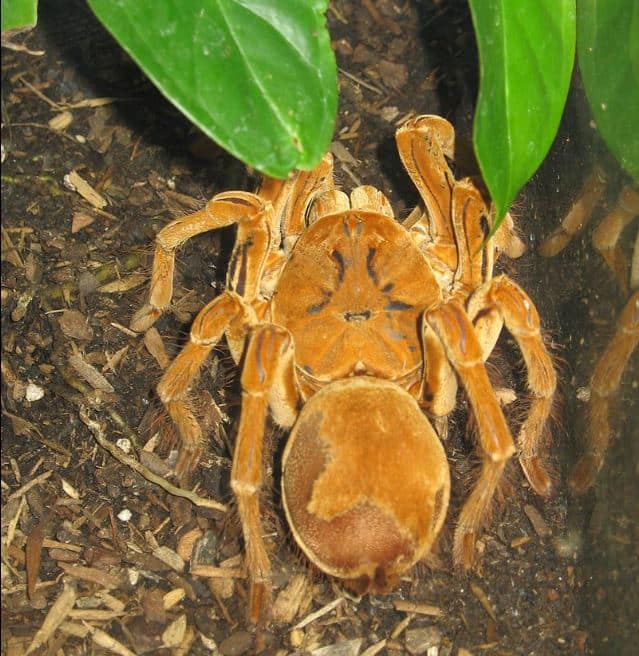
The thing you’ll first notice about the Goliath Birdeater Tarantula is its large size, but that’s not all there’s to them.
While many tarantulas are brightly colored with interesting patterns the Goliath Birdeater flips this paradigm on its head and instead opts for uniform brown colors with white bands on its legs.
They might not be the flashiest of the species, but they don’t need to be. Their large size and equally large fangs say more than any fancy color ever could.
They’re also quite hairy, and when you see them you’ll be surprised at how wooly they are in appearance.
Goliath Birdeaters can grow to a size of an incredible 11 inches in leg span, which makes them the largest tarantula species and the second largest spider species, losing out only to the Giant Huntsman. In weight, however, they are the undisputed kings and a fully grown female can weigh as much as a newborn puppy.
Males and females are dimorphic, with males being significantly thinner and smaller than females who have a much larger abdomen and carapace.
They are visually quite similar to the T. Stirmi, but the Blondi is slightly bigger, has longer hair, and has a more wooly appearance. In addition, Blondi males lack Tibial Hooks.
Price
The Goliath Birdeater is one of the most popular spiders in the hobby which can drive the price up. Unsexed slings are the cheapest to buy and can be found for around $100 to $150.
Males typically cost around $200 to $300, and females are the most expensive at a price of $500+.
The reason why females are so much more expensive is because of their much longer lifespan and larger size which makes them more desired among collectors.
Temperament & Behavior
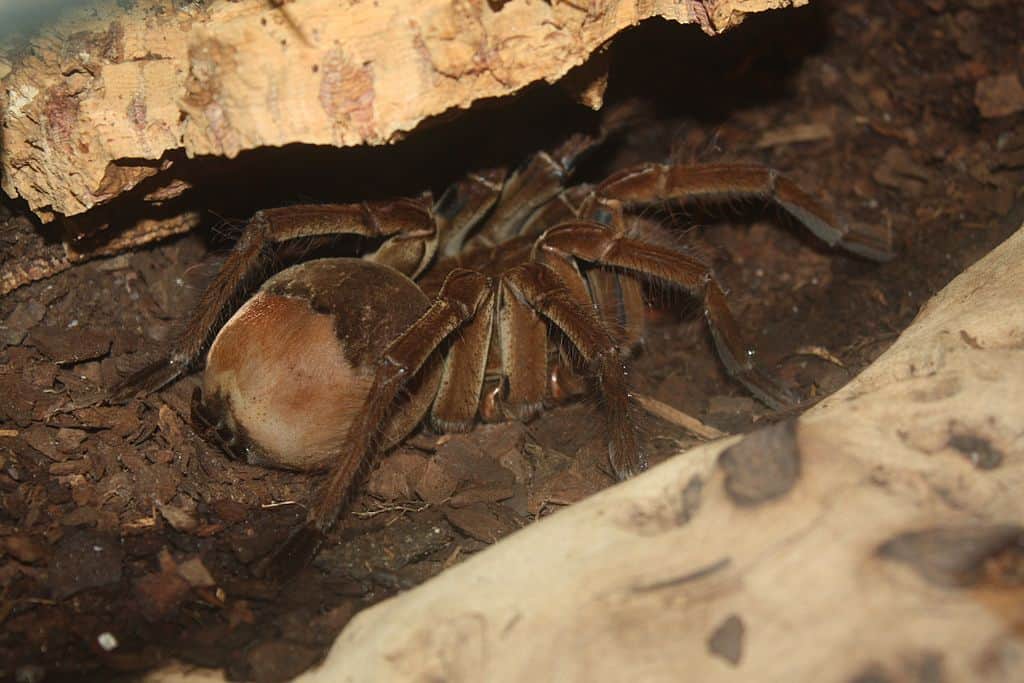
The Goliath Birdeater Tarantula is quite a nervous spider. They’re quick to throw their urticating hairs and do not need much provocation to strike a threat posture.
Their urticating hairs are quite potent and since they’re so quick to throw them you have to be very careful when handling them.
The hairs can cause irritation on the skin, which is bad enough, but if you get them in your nose, mouth, and especially eyes they can do permanent damage.
Make sure that you avoid touching your face and always wash your hands after interacting with this spider.
If they strike a threat posture it’s time to leave them alone because otherwise, they will bite. They have long fangs which can deliver quite a strong bite, and they are also venomous. Luckily, their venom is weak and not threatening to people who do not have allergies.
They are also nocturnal and tend to spend the majority of the day in their burrow, coming out at night.
They do tend to get less nervous as they get older and more used to being kept as pets, but they’re still not recommended for beginners.
They can be extremely quick and their tendency to flick their hairs and put up a threat posture means that it’s best to have some experience with more docile species before trying your hand at the Goliath.
Handling
It’s not recommended to handle the Goliath Birdeater Tarantula due to their nervous nature, fast size, and heavy bodies.
The fact that they can be easily started in combination with their enormous size and terrestrial nature means that it’s quite easy for them to fall off your arm.
With their heavy size, falls can be deadly for them because they can rupture their abdomen.
Some owners do choose to handle their Blondis, but you have to be very careful when doing so. Keep in mind that tarantulas do not need affection and that they would prefer to be left alone as much as possible. Some specimens might tolerate being handled, but they do not need or enjoy it.
Caring for a Goliath Birdeater Tarantula
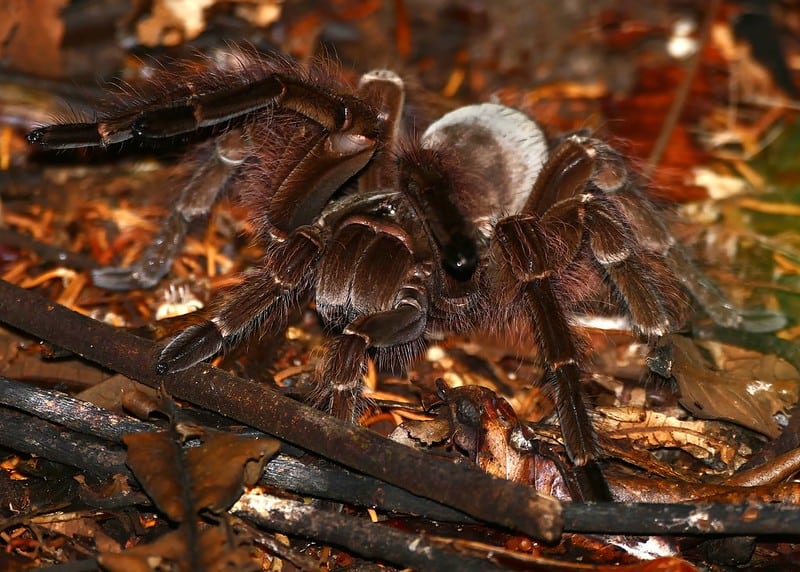
Tarantulas are very low-maintenance pets. They really don’t require a lot to be happy. As long as you feed them and give them a good clean enclosure with a nice climate and good substrate they will be able to thrive.
Here’s exactly what you need to provide your Goliath Birdeater with in order for them to live a good life.
Tank setup
Goliath Birdeaters are large, so they need an enclosure that’s big enough to accommodate them. Make sure that you give adults at least 24L”x16W”x16H” of space.
Slings and juveniles can of course have a much smaller enclosure, as long as you rehouse them to a bigger enclosure as they grow.
Horizontal space is much more important for them than vertical space because they’re a terrestrial species. They do not climb, so as long as they have enough vertical space in their enclosure that it’s not cramped they will be okay.
They are opportunistic burrows, so the best hide for them will be if you provide them with a piece of cork bark that’s placed partly under the substrate so that they can use it as a starter burrow, like so.
You can also place some rocks and artificial or real plants in their enclosure to make it more appealing.
Substrate
As opportunistic burrows, substrate is quite important for these big fellows. Make sure that they have a layer of substrate that’s about as thick as their leg span.
So, if you have a 10″ spider, provide them with 10 inches of substrate. This gives them plenty of space to create their burrow.
Good material to use as substrate is a mixture of coconut fibers, peat moss, vermiculite, and topsoil. This is easy for them to burrow in and does a good job of retaining moisture.
Temperature, humidity & ventilation
The Goliath Birdeater is most comfortable in temperatures between 76 and 84 °F. They prefer a humid environment, so try to keep the relative humidity at 80 to 90%.
The humid climate that they enjoy does increase the chance of bacteria, mold, and fungi growing in their enclosure. This is not good and can even result be lethal for them. To reduce the chance of this happening, make sure that you provide their cage with ample ventilation and that you remove uneaten food in a timely manner.
Additionally, to control humidity levels you might want to consider creating a bioactive enclosure with real plants. This is difficult to do well, but if done right, it can provide an amazing environment for your spider.
Social
Some tarantulas species are capable of living together, but the Goliath Birdeater is not one of them. In the wild, they only meet other members of their species when it’s time to mate.
They cannot be housed communally because they’re quite territorial and attempting to house them together will not end well.
To protect your Goliath Birdeater Tarantula, make sure that you give them enough space in a solitary enclosure.
Molting
The Goliath Birdeater Tarantula is a massive spider that grows incredibly quickly. As a result, they will molt frequently. Molting is the process of them shedding their exoskeleton so that they can keep growing.
An important thing to know about the molting process is that they will refuse to eat while they’re in pre-molt. This is normal behavior and is something all tarantulas do because it makes it easier for them to shed their exoskeleton.
Also, while they are molting, make sure that you do not disturb them. Disturbing them during this stressful time can result in a failed molt where they can lose legs or fangs.
Lastly, avoid feeding them for several days after a molt. Their fangs are not hard enough for them to be able to eat their prey right after a molt, so give them some time for their fangs to harden.
Diet and Feeding
Goliath Birdeater Tarantulas have a large appetite befitting for their size, but they thrive on a diet that consists of insects.
Spiderlings should eat primarily flightless fruit flies, cricket legs, or baby crickets. You can feed the slings as much as you want because there’s not really any risk of overfeeding them at this stage of their life.
As they grow into juveniles, you can start feeding them 3 to 4 medium crickets every 7 to 10 days.
Once they’re adults, you can start feeding them 3 to 4 large dubia roaches, or about 7 to 8 large crickets every 2 weeks or so. They can also eat a variety of other insects, such as mealworms, superworms, and hornworms, which can be a nice variety in their diet.
Some owners choose to feed them mice or small lizards as well, but this is definitely not necessary and can even be dangerous to your tarantula, so I recommend against doing so.
As for drinking, slings will typically drink droplets that they find around their enclosure. Adults drink from a water bowl. Make sure to renew the water frequently to avoid the buildup of bacteria.
Lifespan & Health
Goliath Birdeater Tarantulas have a very long lifespan. Females can live for up to 25 years, but males live much shorter at around 5 years.
To keep your spider healthy it’s important that you prevent the growth of bacteria and fungus. In addition, you should also make sure to avoid them getting parasites and prevent falls.
To prevent the growth of bacteria and fungus you should provide their enclosure with enough ventilation and make sure that you remove uneaten food within 24 hours. Also, make sure to remove any molts that your spider might leave behind.
Parasites can be avoided by only feeding captive-bred insects to your tarantula. Wild-caught insects are not suitable as feed because they can contain parasites that can be transferred to your tarantula when they eat them.
Falls can be prevented by not handling them, and if you do decide to handle them, make sure you do it close to the ground, above a soft surface, so that in case of a fall they do not rupture their abdomen. In addition, you should ensure that their cage is not too tall so that if they decide to climb on the glass and fall it will not be too damaging.
Goliath Birdeater Tarantula Facts
- They can weigh up to 6 ounces, making them the heaviest spider in the world
- In some cultures in South America, the T. Blondi is considered a delicacy and is eaten by the local population
- Females can lay between 100 and 200 eggs, which hatch in 6 to 8 weeks
- The Goliath Birdeater is known to occasionally eat snakes
- Though large, their venom is quite weak and is about as painful as a bee sting
Final words
The Goliath Birdeater Tarantula is a behemoth of a spider, which has caused it to attract the attention of millions of people around the globe. They might not have the most flashy colors, but their large size and fluffy appearance are enough to make them stand out from the other 800+ species.
While many people dream of adding this spider to their collection, they’re not very suitable for beginners. If you’ve never owned a big spider before, it’s best to start with some more docile species to get your feet wet.
Once you’ve gotten some experience with more docile spiders, such as the Arizona Blonde or the Mexican Red knee, you’ll feel much more comfortable taking care of the Goliath Birdeater Tarantula.
- How Long Do American Eskimo Dogs Live? Important Factors and Care Tips - September 29, 2023
- Do American Bulldogs Need Grooming? Essential Tips and Care Guidelines - September 29, 2023
- Do Bengal Cats Enjoy Playing? Essential Tips for Keeping Them Active - September 29, 2023
